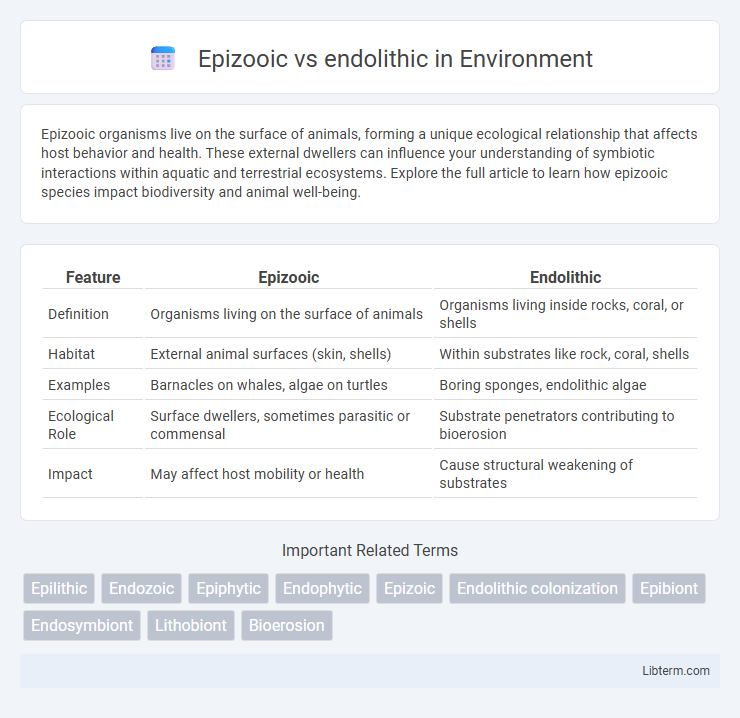Epizooic organisms live on the surface of animals, forming a unique ecological relationship that affects host behavior and health. These external dwellers can influence your understanding of symbiotic interactions within aquatic and terrestrial ecosystems. Explore the full article to learn how epizooic species impact biodiversity and animal well-being.
Table of Comparison
| Feature | Epizooic | Endolithic |
|---|---|---|
| Definition | Organisms living on the surface of animals | Organisms living inside rocks, coral, or shells |
| Habitat | External animal surfaces (skin, shells) | Within substrates like rock, coral, shells |
| Examples | Barnacles on whales, algae on turtles | Boring sponges, endolithic algae |
| Ecological Role | Surface dwellers, sometimes parasitic or commensal | Substrate penetrators contributing to bioerosion |
| Impact | May affect host mobility or health | Cause structural weakening of substrates |
Introduction to Epizooic and Endolithic Terms
Epizooic organisms live on the surface of animals, forming symbiotic or parasitic relationships that influence host ecology and health. Endolithic organisms inhabit the interior of rocks, coral skeletons, or shells, playing critical roles in bioerosion and nutrient cycling within marine and terrestrial ecosystems. Understanding the distinction between epizooic and endolithic lifestyles is essential for studying habitat specialization and species interactions in various environmental contexts.
Defining Epizooic Organisms
Epizooic organisms are those that live on the surface of animals, often forming symbiotic relationships or acting as parasites without penetrating the host's body. They differ from endolithic organisms, which inhabit the interior substrates, such as rock or bone, by excavating or living within these solid structures. Epizooic communities play crucial roles in marine ecosystems by influencing the behavior and health of their animal hosts.
Defining Endolithic Organisms
Endolithic organisms are microbes that live inside the microscopic pores and crevices of rocks, corals, and shells, adapting to harsh environmental conditions by penetrating and inhabiting these substrates. Unlike epizoic organisms that live on the surface of other living animals, endoliths colonize endolithic habitats, contributing to bioerosion and nutrient cycling in marine and terrestrial ecosystems. These organisms include bacteria, fungi, and algae, which exhibit specialized mechanisms for survival within mineral matrices.
Key Differences Between Epizooic and Endolithic
Epizooic organisms live on the surface of living animals, often forming symbiotic relationships or acting as parasites, while endolithic organisms inhabit the interior of rocks, shells, or coral skeletons, penetrating solid substrates. Epizooic species primarily interact with the external environment and host mobility, whereas endolithic species adapt to harsh microenvironments inside mineral matrices, contributing to bioerosion and substrate alteration. The key differences lie in habitat location--external versus internal--and ecological roles related to host interaction and substrate colonization.
Ecological Roles of Epizooic Species
Epizooic species, living on the external surfaces of aquatic animals, significantly influence ecological interactions by providing habitat and food sources for various microorganisms and invertebrates, thereby enhancing biodiversity and nutrient cycling. These organisms often engage in mutualistic relationships, protecting their hosts from fouling by harmful biofilms or predators. Their presence also affects community dynamics and energy flow within aquatic ecosystems, distinguishing their ecological role from endolithic species that bore into substrates and primarily contribute to bioerosion and habitat modification.
Ecological Functions of Endolithic Species
Endolithic species, which inhabit the interior of rocks, coral skeletons, and other hard substrates, play a crucial role in bioerosion and nutrient cycling within marine ecosystems. By breaking down calcium carbonate structures, these microorganisms contribute to habitat modification and facilitate colonization by other reef organisms. Their ecological functions support biodiversity, promote reef resilience, and influence carbonate balance in coral reef environments.
Examples of Epizooic vs Endolithic Habitats
Epizooic habitats are characterized by organisms living on the surface of animals, such as barnacles on whales and algae on turtle shells, providing symbiotic or commensal relationships. Endolithic habitats are defined by organisms inhabiting the interior of rocks or living inside calcium carbonate structures, examples include cyanobacteria boring into limestone and sponges residing within coral skeletons. These distinct habitats highlight ecological adaptations in marine environments with epizooic species exposed externally and endolithic species adapted to protected internal niches.
Adaptations of Epizooic and Endolithic Organisms
Epizooic organisms adapt by developing specialized attachment structures such as suction cups, hooks, or adhesive secretions to cling onto the surface of hosts or substrates, allowing them to access nutrients and avoid predators. Endolithic organisms exhibit adaptations including the ability to bore into or chemically dissolve rock, coral, or shell substrates, often possessing enzymes and acid secretion mechanisms to penetrate and inhabit interior spaces for protection and steady resource availability. Both strategies demonstrate evolutionary solutions for survival in distinct microhabitats, with epizooic species optimized for external colonization and endolithic species for subsurface habitation.
Importance in Marine and Terrestrial Ecosystems
Epizoic organisms, living on the surface of marine or terrestrial hosts, play a crucial role in ecosystem dynamics by facilitating nutrient cycling and providing habitats for microorganisms, which enhances biodiversity and ecosystem resilience. Endolithic organisms, inhabiting the interior of rocks or hard substrates, contribute to bioerosion and mineral weathering, influencing soil formation and nutrient availability in both marine and terrestrial environments. The interaction between epizoic and endolithic communities supports the stability of coral reefs, rock surfaces, and soil crusts, underpinning essential ecological processes and maintaining habitat complexity.
Future Research Directions and Applications
Future research directions in epizooic and endolithic studies emphasize advanced molecular techniques to better understand microbial interactions with host organisms and substrates. Applications include biotechnological innovations in bioremediation, biomineralization, and the development of novel biofilms for industrial use. Exploring the ecological roles and resilience mechanisms of these organisms under climate change will drive sustainable environmental management strategies.
Epizooic Infographic

 libterm.com
libterm.com